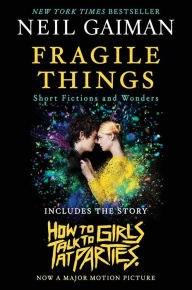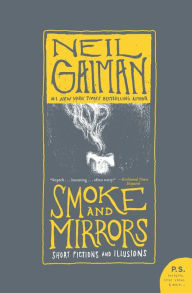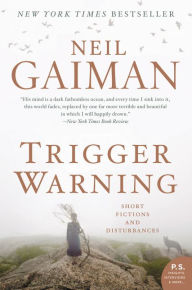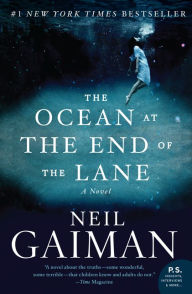7 Neil Gaiman Stories We Need to See on the Big Screen
Fragile Things: Short Fictions and Wonders
Fragile Things: Short Fictions and Wonders
By Neil Gaiman
In Stock Online
Paperback $16.99
As a writer, most everything Neil Gaiman touches turns to gold. But as we have established before, he might just be his peak when writing short fiction. (We’re big fans, okay?) This summer, the broader world gets a taste of those brief delights with the film adaptation of How to Talk to Girls at Parties, previously published in Gaiman’s short-story collection Fragile Things and now directed by John Cameron Mitchell (Hedwig and the Angry Inch).
As a writer, most everything Neil Gaiman touches turns to gold. But as we have established before, he might just be his peak when writing short fiction. (We’re big fans, okay?) This summer, the broader world gets a taste of those brief delights with the film adaptation of How to Talk to Girls at Parties, previously published in Gaiman’s short-story collection Fragile Things and now directed by John Cameron Mitchell (Hedwig and the Angry Inch).
The release of the movie—about the alluring danger of flirting with aliens—got us thinking: what other Gaiman shorts would be perfect for the big screen? We’ve already seen how well Gaiman’s novels fit with Hollywood thanks to the manic delight that is Stardust; the creepy, crawly stop-motion adaptation of Coraline; and the addictive weirdness of the American Gods TV series. The following short stories seem like perfect cinematic matches, too.
Smoke and Mirrors: Short Fictions and Illusions
Smoke and Mirrors: Short Fictions and Illusions
By Neil Gaiman
Paperback $15.99
“Chivalry” (Smoke and Mirrors)
This story sings from the very first, matter-of-fact line: “Mrs. Whitaker found the Holy Grail; it was under a fur coat.” From there follows a tale of whimsy, filled with bargain shopping and knightly quests. It has the same quiet, humble tone as its protagonist, and stands out as a buoyant departure from the author’s more macabre offerings. The darkest part of this story is that the film rights for “Chivalry” were indeed bought up—albeit two decades ago, and by one by Harvey Weinstein (hiss!). Here’s hoping the universe hears the author’s plea and delivers this story into the hands of someone who can do it gallant justice.
“Chivalry” (Smoke and Mirrors)
This story sings from the very first, matter-of-fact line: “Mrs. Whitaker found the Holy Grail; it was under a fur coat.” From there follows a tale of whimsy, filled with bargain shopping and knightly quests. It has the same quiet, humble tone as its protagonist, and stands out as a buoyant departure from the author’s more macabre offerings. The darkest part of this story is that the film rights for “Chivalry” were indeed bought up—albeit two decades ago, and by one by Harvey Weinstein (hiss!). Here’s hoping the universe hears the author’s plea and delivers this story into the hands of someone who can do it gallant justice.
“The Truth Is a Cave in the Black Mountains” (Trigger Warning)
What’s better than a revenge story? Not much. This grim quest has an intimacy and a drive—as well as a fairy-tale appeal—that would suit a film treatment. At its core is a two-pronged journey undertaken by an unnamed narrator: one to a legendary cave piled with otherworldly gold, and one to deliver terrible family vengeance. The story has suspense, tension, and creeping tendrils of mythology that could translate to any number of media.
Trigger Warning: Short Fictions and Disturbances
Trigger Warning: Short Fictions and Disturbances
By Neil Gaiman
In Stock Online
Paperback $16.99
“The Case of Death and Honey” (Trigger Warning)
You can’t argue with the longevity of Sherlock Holmes. The consulting detective’s been put in just about every situation imaginable, in every medium. Even Gaiman has put him through his paces more than once, in “Death and Honey” and “A Study in Emerald.” “Death and Honey” finds an older Holmes, retired, and on the verge of saying a permanent goodbye to his ailing brother, Mycroft, and intending to solve life’s biggest mystery—death—with the help of Chinese bees. It’s a quiet story, but one with a familiar face and a big payoff—not to mention bittersweet paeans like, “I do not, and did not, believe in empires. But I believed in Mycroft.”
“The Case of Death and Honey” (Trigger Warning)
You can’t argue with the longevity of Sherlock Holmes. The consulting detective’s been put in just about every situation imaginable, in every medium. Even Gaiman has put him through his paces more than once, in “Death and Honey” and “A Study in Emerald.” “Death and Honey” finds an older Holmes, retired, and on the verge of saying a permanent goodbye to his ailing brother, Mycroft, and intending to solve life’s biggest mystery—death—with the help of Chinese bees. It’s a quiet story, but one with a familiar face and a big payoff—not to mention bittersweet paeans like, “I do not, and did not, believe in empires. But I believed in Mycroft.”
“A Lunar Labyrinth” (Trigger Warning)
Gaiman at his creepy best, “Lunar Labyrinth” would make a suitably suspenseful and tasteful date-night movie. The story starts with your average Joe, tooling through hokey tourist traps, a roadside sampling that brings him to the titular labyrinth. Whether the labyrinth possesses the power to heal or hurt is the real question, one that Gaiman draws out with perfect, taut suspense. Perfect viewing for October, like a grown-up Goosebumps.
“The Sleeper and the Spindle” (Trigger Warning)
“Snow, Glass, Apples” is one of the darker entries in Gaiman’s short-fiction canon, a bleak alternative look at Snow White’s “evil” queen. While gorgeously designed, it might not be as easily suited to the big screen as its cousin of a retelling, “The Sleeper and the Spindle,” which weaves together elements of Snow White and Sleeping Beauty. This tale of a queen and a princess puts the so often acted-upon young women of fairy tales in the driver’s seat for an adventure that is subtly subversive and so perfectly suited to our times.
The Ocean at the End of the Lane
The Ocean at the End of the Lane
By Neil Gaiman
Paperback $15.99
“The Facts in the Case of the Departure of Miss Finch” (Fragile Things)
With its bizarro setting and its straight-laced fourth wheel, “Miss Finch” delivers the fish-out-of-water fantasy Gaiman’s known for, allowing the fantastic to intrude jarringly on our own world—in this case, London. And it’s relatable:who among us hasn’t taken our persnickety co-worker to a fly-by-night circus and misplaced her, only to realize she may have had the most jaw-dropping time of all? If you’ve yet to have that misfortune, maybe take your unpleasant acquaintances to the trippy picture show instead, and endeavor to lose them in the popcorn line.
“The Facts in the Case of the Departure of Miss Finch” (Fragile Things)
With its bizarro setting and its straight-laced fourth wheel, “Miss Finch” delivers the fish-out-of-water fantasy Gaiman’s known for, allowing the fantastic to intrude jarringly on our own world—in this case, London. And it’s relatable:who among us hasn’t taken our persnickety co-worker to a fly-by-night circus and misplaced her, only to realize she may have had the most jaw-dropping time of all? If you’ve yet to have that misfortune, maybe take your unpleasant acquaintances to the trippy picture show instead, and endeavor to lose them in the popcorn line.
The Ocean at the End of the Lane
All right, so it’s not technically a short story, but it is a novella, which is a cousin to the short story at the very least. And this slim book has a delicate, dream-like beauty that deserves to be read and seen. When a narrator returns to his childhood English home, he uncovers memories of a mysterious summer and the magical girl at the heart of it, Lettie Hempstock. We use the descriptor “fairy tale” quite a bit when discussing Gaiman’s works, but that’s exactly the kind of adventure and fright the two kids encountered, an experience that has all the makings of a perfect portal fantasy film to delight all ages.
What Neil Gaiman story would you choose for adaptation?



